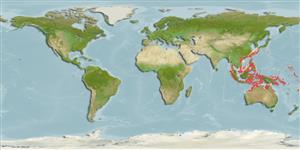Environment: milieu / climate zone / depth range / distribution range
Ekologi
laut berasosiasi dengan karang; kisaran kedalaman 40 - 130 m (Ref. 5222). Tropical; 34°N - 20°S, 92°E - 177°W
Western Pacific: Andaman Sea to southern Japan, Taiwan, China, Philippines, Viet Nam, Malaysia, Thailand, Indonesia, New Guinea, the Arafura Sea (Ref. 9819), northwestern Australia, and Fiji.
Size / Weight / umur
Maturity: Lm ? range ? - ? cm
Max length : 50.0 cm TL jantan/; (Ref. 5222)
Duri punggung (Keseluruhan (total)): 11; duri punggung lunak (Keseluruhan (total)): 15-16; Duri dubur 3; Sirip dubur lunak: 8. This species is distinguished by the following characters: body depth less than head length, 2.5-3.0 times in SL; large head length 2.1-2.4 times in SL; rounded preopercle with 3-6 enlarged serrae at the angle; upper edge of operculum slightly convex; midside of lower jaw with 2 rows of teeth; gill rakers of first gill arch 8 + 14-16 = 22-24; scaly maxilla, reaching about vertical at rear edge of eye; pectoral and pelvic fin length are equal, 1.7-2.3 times in head length; ctenoid lateral body scales, few auxiliary scales in adults. Colour of head, body and median fins are pale grey; 5 broad dark brown bars, first 2 extending into the spinous part of dorsal fin, 3rd and 4th bars extending into the soft dorsal and anal fins, 5th dark bar at the base of the caudal fin; edges of dorsal parts of body bars with small black spots; nape with dark brown saddle blotch, small black spots mainly along edge of the blotch; cheeks, snout, interorbital area, jaws and chest mostly dark brown, with 2-3 white bands radiating from the eye; irregular black bar on the middle of the caudal fin; yellow maxillary groove; small juveniles (6 cm SL) white, with black bars on body as described for adults, the fins pale yellow with small black spots (Ref. 39231, 89707).
This species is usually found on offshore coral and rocky reefs. A popular and commercially important species in Hong Kong, but not in Singapore. Caught with hand lines and sold fresh (Ref. 39231).
Life cycle and mating behavior
Kematangan | Reproduksi, perkembang biakan | Pemijahan | telur-telur | Fecundity | Larva
Heemstra, P.C. and J.E. Randall, 1993. FAO Species Catalogue. Vol. 16. Groupers of the world (family Serranidae, subfamily Epinephelinae). An annotated and illustrated catalogue of the grouper, rockcod, hind, coral grouper and lyretail species known to date. Rome: FAO. FAO Fish. Synop. 125(16):382 p. (Ref. 5222)
Status IUCN Red List (Ref. 130435)
ancaman kepada manusia
Harmless
penggunaan manusia
Perikanan: nilai komersial kecil
informasi lanjut
Nama-nama umumSinonim (persamaan)metabolismePemangsaEkotoksikologiReproduksi, perkembang biakanKematanganPemijahanSpawning aggregationFecunditytelur-telurpekembangan telor
AcuanBudidaya airprofil budidaya airStrainGenetikaElectrophoresesDiturunkanPenyakit-penyakitPengolahanNutrientsMass conversion
mitraGambarStamps, Coins Misc.Suara-suaraCiguateraKecepatanTipe renangArea insangOtolithsOtakPenglihatan / visi
Alat, peralatan
laporan khas
muat turun XML
Sumber internet
Estimates based on models
Preferred temperature (Ref.
123201): 20.2 - 27.6, mean 23.9 °C (based on 136 cells).
Phylogenetic diversity index (Ref.
82804): PD
50 = 0.5000 [Uniqueness, from 0.5 = low to 2.0 = high].
Bayesian length-weight: a=0.01175 (0.00571 - 0.02419), b=3.04 (2.88 - 3.20), in cm total length, based on LWR estimates for this Genus-body shape (Ref.
93245).
Trophic level (Ref.
69278): 3.8 ±0.5 se; based on size and trophs of closest relatives
Daya lenting (Ref.
120179): sedang, Waktu penggandaan populasi minimum 1.4 - 4.4 tahun (Preliminary K or Fecundity.).
Fishing Vulnerability (Ref.
59153): Moderate vulnerability (40 of 100).
Nutrients (Ref.
124155): Calcium = 27.2 [13.3, 56.6] mg/100g; Iron = 0.481 [0.260, 0.967] mg/100g; Protein = 18.5 [16.9, 19.8] %; Omega3 = 0.134 [0.086, 0.211] g/100g; Selenium = 40 [24, 68] μg/100g; VitaminA = 186 [54, 642] μg/100g; Zinc = 1.26 [0.89, 1.76] mg/100g (wet weight);
